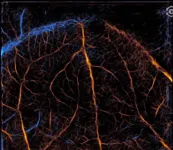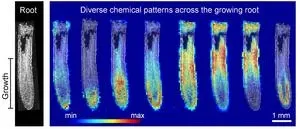(Press-News.org) Researchers at the Beckman Institute for Advanced Science and Technology used deep learning to develop a new framework for super-resolution ultrasound.
Traditional super-resolution ultrasound techniques use microbubbles: tiny spheres of gas encased in a protein or lipid shell. Microbubbles are considered to be a contrast agent, which means they can be injected into a blood vessel to increase the clarity of an ultrasound image.
Conventional ultrasound has been commonplace for over 50 years. The development of super-resolution technology in the last decade has introduced new challenges. Super-resolution ultrasound provides a much clearer picture than the traditional method. Although useful for research and diagnostics, its processing speeds are much slower.
“Conventional imaging cannot differentiate vessels that are too close to each other,” said Pengfei Song, an assistant professor of electrical and computer engineering at the University of Illinois Urbana-Champaign and an author on the paper. “With super resolution imaging, you can actually make that distinction and tell if there are two vessels or a single vessel. You can tell the shape of the vessels, and sometimes there are diagnostic implications, like with cancerous tumors. But clinical translation has been difficult because nobody’s going to wait in a hospital for hours for these images to get processed.
"Ultrasound is expected to be a real-time imaging modality.”
This challenge prompted Song to team up with fellow Beckman researcher Dr. Daniel Llano, an associate professor of molecular and integrative physiology and a neurologist at Carle Foundation Hospital. Together, the researchers tested a new approach to super-resolution ultrasound technology.
Their paper appears in IEEE Transactions on Medical Imaging.
“As engineers, we develop tools that we think will be useful for researchers, but sometimes we miss the mark,” Song said. “This is a case where the user of the technology, like Professor Llano, tells us how we have to improve the technology: make it faster.”
Traditional super-resolution ultrasound techniques produce crisp, vibrant images, but the process is lengthy because it requires a very low concentration of microbubbles. For researchers like Llano, every minute counts.
In response to Llano’s feedback, the Song group returned to the drawing board and decided to revamp the super-resolution technology, forgoing microbubble localization and tracking entirely. Instead of evaluating data frame by frame, the researchers used a holistic approach and evaluated the information spatiotemporally — over space and time. Using an artificial intelligence network, the technology was able to determine the speed of blood flow and convert a blurred image to a clearer one with a high resolution.
“In conventional super-resolution ultrasound, the signal is very blurred out,” said Matt Lowerison, a Beckman Institute Postdoctoral Fellow and an author on the paper. “We have to try and find the center of this very blurred-out point to produce these super localized dots on an image. And then over time, we can slowly start to accumulate these dots into a super-resolved image. But the big limitation is that it takes forever. Our approach, which uses a deep learning network, avoids this whole very expensive process and just produces a super resolution image without having to worry about any of this explicit identification of microbubbles.”
Because conventional super-resolution ultrasound is so slow, the end product is likened to a still image. But with the researchers’ new method, blood flow can be visualized in real time.
“To the best of our knowledge, this is the first paper that achieved direct calculation of the blood flow velocity, both speed and direction, using raw ultrasound data without any explicit microbubble localization or tracking,” Song said.
As a result, processing speeds have been reduced from minutes to seconds, and post-processing can be done in real time. The researchers hope that speeding up the higher-resolution technology will make it a useful option for clinicians.
“We’ve done human imaging before with conventional imaging, but it’s challenging,” Song said. “We think that this technique has the potential for super resolution to be finally used in a clinical setting.”
Collaboration between the two research groups was made possible through the shared environment at Beckman.
“Professor Llano’s home department is molecular and cellular biology, so without Beckman this collaboration would not have been possible, because we need to have a common lab space,” Song said. “It’s really the common physical space that made this happen.”
Editor’s note:
The paper titled "Localization free super-resolution microbubble velocimetry using a long short-term memory neural network" can be accessed online at https://doi.org/10.1109/TMI.2023.3251197.
Additional authors of the paper included Xi Chen and Zhijie Dong of the department of electrical and computer engineering and Nathiya Vaithiyalingam Chandra Sekaran of the department of molecular and cellular biology. Sekaran is a current Beckman Institute Postdoctoral Fellow.
END
New framework for super-resolution ultrasound
Researchers at the Beckman Institute for Advanced Science and Technology used deep learning to develop a new framework for super-resolution ultrasound
2023-05-25
ELSE PRESS RELEASES FROM THIS DATE:
Simon Fraser University becomes global instructor training facility for Siemens mechatronic systems certification program
2023-05-25
Responding to a growing need for training in automation systems in Canada and globally, Siemens and Simon Fraser University (SFU) have announced that SFU is the first and only training facility for instructors delivering the globally recognized Level 3 Siemens Mechatronic Systems Certification program (SMSCP). Instructors, upon completion of the two-week long training will be qualified to deliver the Level 3 certification mechatronics training, vital for providing students with real-world technical skills, and helping prepare them to thrive in a high-tech world of work. Level 1 and Level 2 ...
Reconstructing brain connectivity using 3D images
2023-05-25
Dr. Shuiwang Ji, a professor in the Department of Computer Science and Engineering at Texas A&M University, is part of a collaborative research community that recently had its paper titled “BigNeuron: a resource to benchmark and predict performance of algorithms for automated tracing of neurons in light microscopy datasets” published in the April issue of the journal Nature Methods.
Initiated in 2015 and led by the Allen Institute for Brain Science, BigNeuron is an international initiative that brings together computer scientists and neuroscientists from a dozen institutions. ...
Words matter: How researchers can avoid stigmatizing language
2023-05-25
Word choice matters—a lot— when it comes to research. That’s the main takeaway from a new article co-authored by Edson College of Nursing and Health Innovation Assistant Professor Angel Algarin and published in Health Communication.
“Researchers in any field should be cognizant of the language they’re using to describe the people they study so they don’t inadvertently add to the use of stigmatizing language,” said Algarin.
For the article, Algarin and his co-authors performed a content ...
Chip-based QKD achieves higher transmission speeds
2023-05-25
WASHINGTON — Researchers have developed a quantum key distribution (QKD) system based on integrated photonics that can transmit secure keys at unprecedented speeds. The proof-of-principle experiments represent an important step toward real-world application of this highly secure communication method.
QKD is a well-established method of providing secret keys for secure communication between distant parties. By using the quantum properties of light to generate secure random keys for encrypting and ...
The brain’s protein-destruction machine learns new tricks at synapses, revealing a potential target for treating neurological disorders
2023-05-25
Darwin’s theory of evolution highlighted the importance of adaption and diversity in the natural world. Inside a biological cell, can proteins also perform new functions in new contexts? The answer seems to be yes for the brain’s primary protein-degradation machine, especially when it is placed at synapses, revealing a hitherto unknown mechanism that allows synapses to change in response to different circumstances.
The role of the regulatory (19S) proteasome particle has always been exclusively linked to its functioning in the proteasome complex, where it collaborates with the catalytic (20S) particle to recognize ...
Polar fish are less likely to die early, so they prioritize growth over reproduction
2023-05-25
Polar fish experience lower mortality than tropical fish, allowing them to delay reproduction until later in life when they are larger and can produce more eggs, according to a study by Mariana Álvarez-Noriega at Monash University in Australia and colleagues, publishing May 25th in the open access journal PLOS Biology. This may have implications for the effects of climate change on the sustainability of fish populations.
Organisms face a trade-off around when is the best time to reproduce. Fish continue to grow throughout life and larger fish tend to produce disproportionately more eggs than smaller fish, so it ...
Arctic ground squirrels changing hibernation patterns
2023-05-25
Arctic ground squirrels are unique among mammals. Their ability to keep from freezing even when body temperatures dip below that mark on the thermometer enables them to survive extreme winter climates. New research published in Science analyzes more than 25 years of climate and biological data. The findings include shorter hibernation periods and differences between male and female hibernation periods. Spoiler alert - the girls “rise and shine” a little earlier in response to warming, which could have both positive and negative ripple effects throughout the food web in these ecosystems.
Senior ...
As Arctic warms, female arctic ground squirrels end hibernation before males – a mismatch with consequences
2023-05-25
As Alaskan permafrost warms, hibernating arctic ground squirrels generate less heat, causing females to emerge from hibernation up to 10 days before their male counterparts – a mismatch that could have large, cascading ecological impacts. The findings of the related study reveal both direct and indirect impacts of a warming world. Winter temperatures play a fundamental role in fitness and population dynamics for many species that live in higher latitudes. However, in the Arctic, where warming is occurring more rapidly than most other places on ...
Stressed soil microbial communities bolster tree resilience to changing climates
2023-05-25
Soil microbiota transplanted from more stressful environmental conditions – drought or excessive heat or cold, for example – can enhance tree tolerance to changing climates, researchers report. The findings suggest that management of soil microbiota, especially during forest restorations, could be a valuable strategy for increasing forest resilience to climate change. Climate change is forcing many species outside of their evolved range of environmental tolerances, forcing them to acclimate, adapt, or migrate to avoid extinction. For long-lived ...
Combining data types refines grasp of French Canadian ancestry in Quebec, revealing how local topographies influenced relatedness, and more
2023-05-25
Combining a comprehensive dataset – including marriage documents – compiled from more than 4 million Catholic parish records with genotype data for more than 22,000 French and French Canadian individuals, researchers have conducted a novel analysis of French Canadian ancestry in Quebec, Canada, since the 17th Century. While most other population genetic models provide only coarse representations of a region’s real-world ancestry, this new approach reveals detailed insights into historic European colonization, migration, and settlement patterns, reflecting intricate French Canadian population structures within geographic constraints. ...
LAST 30 PRESS RELEASES:
Scientists trace microplastics in fertilizer from fields to the beach
The Lancet Obstetrics, Gynecology, & Women’s Health: Taking paracetamol during pregnancy does not increase risk of autism, ADHD or intellectual disabilities, confirms new gold-standard evidence review
Taking paracetamol during pregnancy does not increase risk of autism, ADHD or intellectual disabilities
Harm reduction vending machines in New York State expand access to overdose treatment and drug test strips, UB studies confirm
University of Phoenix releases white paper on Credit for Prior Learning as a catalyst for internal mobility and retention
Canada losing track of salmon health as climate and industrial threats mount
Molecular sieve-confined Pt-FeOx catalysts achieve highly efficient reversible hydrogen cycle of methylcyclohexane-toluene
Investment in farm productivity tools key to reducing greenhouse gas
New review highlights electrochemical pathways to recover uranium from wastewater and seawater
Hidden pollutants in shale gas development raise environmental concerns, new review finds
Discarded cigarette butts transformed into high performance energy storage materials
Researchers highlight role of alternative RNA splicing in schizophrenia
NTU Singapore scientists find new way to disarm antibiotic-resistant bacteria and restore healing in chronic wounds
Research suggests nationwide racial bias in media reporting on gun violence
Revealing the cell’s nanocourier at work
Health impacts of nursing home staffing
Public views about opioid overdose and people with opioid use disorder
Age-related changes in sperm DNA may play a role in autism risk
Ambitious model fails to explain near-death experiences, experts say
Multifaceted effects of inward foreign direct investment on new venture creation
Exploring mutations that spontaneously switch on a key brain cell receptor
Two-step genome editing enables the creation of full-length humanized mouse models
Pusan National University researchers develop light-activated tissue adhesive patch for rapid, watertight neurosurgical sealing
Study finds so-called super agers tend to have at least two key genetic advantages
Brain stimulation device cleared for ADHD in the US is overall safe but ineffective
Scientists discover natural ‘brake’ that could stop harmful inflammation
Tougher solid electrolyte advances long-sought lithium metal batteries
Experts provide policy roadmap to reduce dementia risk
New 3D imaging system could address limitations of MRI, CT and ultrasound
First-in-human drug trial lowers high blood fats
[Press-News.org] New framework for super-resolution ultrasoundResearchers at the Beckman Institute for Advanced Science and Technology used deep learning to develop a new framework for super-resolution ultrasound




